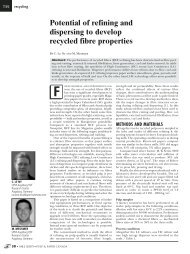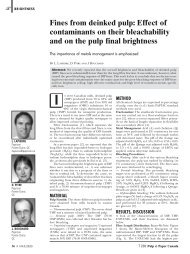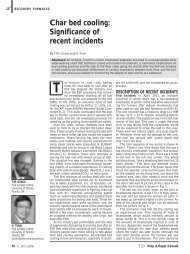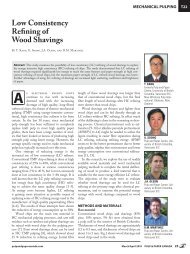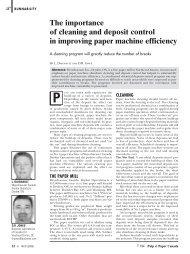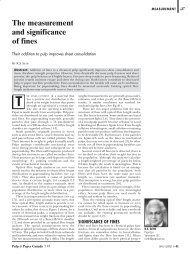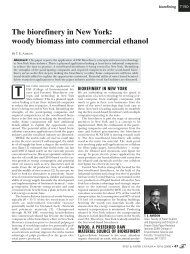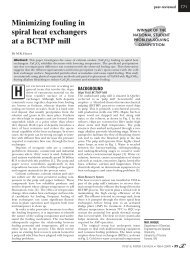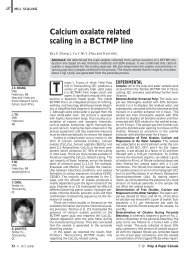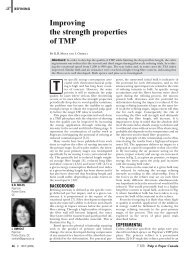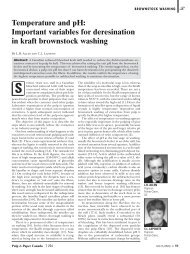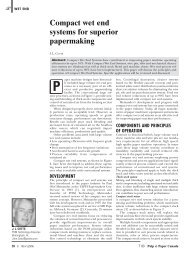Investigation of green lime mud at Harmac mill - Pulp and Paper ...
Investigation of green lime mud at Harmac mill - Pulp and Paper ...
Investigation of green lime mud at Harmac mill - Pulp and Paper ...
Create successful ePaper yourself
Turn your PDF publications into a flip-book with our unique Google optimized e-Paper software.
LIME KILNS<br />
<strong>Investig<strong>at</strong>ion</strong> <strong>of</strong><br />
<strong>green</strong> <strong>lime</strong> <strong>mud</strong><br />
<strong>at</strong> <strong>Harmac</strong> <strong>mill</strong><br />
By K. Taylor <strong>and</strong> D. Bossons<br />
Abstract: Over the past several years, the <strong>Harmac</strong> pulp <strong>mill</strong> has experienced oper<strong>at</strong>ing periods<br />
<strong>of</strong> very poor <strong>lime</strong> <strong>mud</strong> quality <strong>and</strong> upset oper<strong>at</strong>ion <strong>of</strong> the recaust <strong>and</strong> <strong>lime</strong> kiln areas. These upsets<br />
coincided with the occurrence <strong>of</strong> <strong>green</strong> <strong>lime</strong> <strong>mud</strong>. This study investig<strong>at</strong>es the chemistry <strong>of</strong> non-process<br />
elements (NPEs) in the recaust/<strong>lime</strong> kiln cycle, evalu<strong>at</strong>es the effect <strong>of</strong> secondary sludge burning<br />
in the recovery boiler, identifies a possible cause <strong>of</strong> <strong>green</strong> <strong>lime</strong> <strong>mud</strong>, <strong>and</strong> makes recommend<strong>at</strong>ions<br />
to reduce <strong>lime</strong> <strong>mud</strong> filter plugging <strong>and</strong> maximize sludge burning.<br />
H<br />
ARMAC LIME MUD was typically very<br />
white in colour until 2001. Since then,<br />
<strong>lime</strong> <strong>mud</strong> colour has varied from<br />
nearly white to dark <strong>green</strong>. Recaust<br />
upsets such as plugging <strong>of</strong> pressure<br />
<strong>and</strong> rotary <strong>lime</strong> <strong>mud</strong> filters seemed to occur when<br />
the <strong>lime</strong> <strong>mud</strong> was dark <strong>green</strong> in colour. These<br />
incidents <strong>of</strong> poor <strong>lime</strong> <strong>mud</strong> quality were serious<br />
enough to reduce <strong>mill</strong> output due to insufficient<br />
white liquor production. There was a concern<br />
th<strong>at</strong> these process upsets were caused by non-process<br />
elements (NPEs) introduced during the<br />
burning <strong>of</strong> secondary tre<strong>at</strong>ment sludge in the<br />
recovery boiler, which also began in 2001. As a<br />
result, sludge burning was discontinued in June<br />
2004. However, a serious recaust upset with <strong>green</strong><br />
<strong>lime</strong> <strong>mud</strong> occurred from July to October 2004,<br />
casting doubt on sludge burning as the cause <strong>of</strong><br />
the problem. A strong economic incentive exists<br />
to burn sludge in the recovery cycle <strong>at</strong> <strong>Harmac</strong>,<br />
since it reduces oper<strong>at</strong>ing costs by approxim<strong>at</strong>ely<br />
$2 <strong>mill</strong>ion a year.<br />
The <strong>Harmac</strong> pulp <strong>mill</strong>, loc<strong>at</strong>ed on the east<br />
coast <strong>of</strong> Vancouver Isl<strong>and</strong>, is oper<strong>at</strong>ed by Pope &<br />
Talbot. The <strong>mill</strong> was built in three distinct phases<br />
between 1950 <strong>and</strong> 1963, <strong>and</strong> has undergone considerable<br />
moderniz<strong>at</strong>ion over the past 20 years.<br />
The <strong>mill</strong> currently oper<strong>at</strong>es with a capacity <strong>of</strong><br />
1,120 air-dried tonnes (adt/d) <strong>of</strong> fully bleached<br />
market kraft pulp. The recaust was modernized in<br />
the mid-80s <strong>and</strong> combined into a single line. <strong>Harmac</strong><br />
disposes <strong>of</strong> the waste secondary sludge from<br />
its effluent-tre<strong>at</strong>ment process through three<br />
means: dew<strong>at</strong>ering <strong>and</strong> burning in the power<br />
boiler, dew<strong>at</strong>ering <strong>and</strong> sending to l<strong>and</strong>fill, or<br />
direct mixing with the weak black liquor <strong>and</strong><br />
burning in the recovery boilers.<br />
Inciner<strong>at</strong>ion <strong>of</strong> secondary sludge in the recovery<br />
boiler has been <strong>of</strong> interest to the pulp industry<br />
for some time [1]. Economics are favourable,<br />
but the sludge is known to contain <strong>mill</strong>-specific<br />
NPEs th<strong>at</strong> can affect <strong>mill</strong> oper<strong>at</strong>ion [2].<br />
Extensive liter<strong>at</strong>ure searches <strong>and</strong> discussion<br />
with industry experts did not explain the occurrence<br />
<strong>of</strong> <strong>green</strong> <strong>lime</strong> <strong>mud</strong>. Extensive reviews <strong>of</strong> the<br />
effect <strong>of</strong> non-process elements in kraft pulp <strong>mill</strong>s<br />
are available [3-6]. However, none <strong>of</strong> them was able<br />
to shed light on the problems occurring <strong>at</strong> <strong>Harmac</strong>.<br />
Because <strong>of</strong> the favourable economic incentive<br />
<strong>of</strong> sludge burning, <strong>and</strong> the neg<strong>at</strong>ive impact <strong>of</strong><br />
recaust upsets, a research project was initi<strong>at</strong>ed to<br />
address the following objectives:<br />
1. Identify the cause <strong>of</strong> <strong>green</strong> <strong>lime</strong> <strong>mud</strong> <strong>at</strong> <strong>Harmac</strong>;<br />
2. Underst<strong>and</strong> the role <strong>of</strong> NPEs in the <strong>Harmac</strong><br />
process cycle;<br />
3. Evalu<strong>at</strong>e the effect <strong>of</strong> sludge burning on the<br />
<strong>Harmac</strong> process cycle; <strong>and</strong><br />
4. Make recommend<strong>at</strong>ions to reduce <strong>lime</strong> <strong>mud</strong><br />
filter plugging <strong>and</strong> maximize sludge burning.<br />
METHODS, MATERIALS<br />
Metal concentr<strong>at</strong>ions were measured by<br />
Econotech Services Ltd., Delta, BC. After digestion,<br />
samples were analyzed by inductively coupled<br />
plasma (ICP) spectroscopy. Total metals content<br />
was measured in liquid samples.<br />
Step-scan X-ray powder-diffraction d<strong>at</strong>a<br />
(XRD) using the quantit<strong>at</strong>ive Rietveld method<br />
were collected on a st<strong>and</strong>ard Siemens (Bruker)<br />
D5000 Bragg-Brentano diffractometer. These<br />
measurements were performed <strong>at</strong> UBC Department<br />
<strong>of</strong> Earth <strong>and</strong> Ocean Sciences by M. Raudsepp<br />
<strong>and</strong> E. Pani.<br />
Visible light spectroscopy <strong>of</strong> liquid samples was<br />
performed with a Carey 5 UV/VIS/NIR spectrometer<br />
while diffuse reflectance measurements<br />
<strong>of</strong> solids were made with a Carey 1 UV/VIS/NIR<br />
spectrometer.<br />
Brightness <strong>of</strong> <strong>lime</strong> <strong>mud</strong> was measured with a<br />
Technibrite Micro TB-1C (Technidyne Corpor<strong>at</strong>ion,<br />
USA).<br />
Kaolin clay was obtained from Feldspar Corp.<br />
(Florida) as EPK Kaolin <strong>and</strong> contained 97 wt%<br />
kaolinite. Surface area was 24 m 2 /g <strong>and</strong> average<br />
particle size 1.4 microns. Synthetic <strong>green</strong> liquor<br />
contained 1.1M sodium carbon<strong>at</strong>e (ACS grade)<br />
<strong>and</strong> 0.5M sodium sulphide (ACS grade).<br />
Samples for the sludge-burning trial were collected<br />
in acid-washed polyethylene sample containers<br />
to elimin<strong>at</strong>e possible metal contamin<strong>at</strong>ion.<br />
Samples were collected for four days with<br />
normal <strong>mill</strong> oper<strong>at</strong>ion then for seven days burning<br />
sludge <strong>at</strong> 120 US gal/min. One set <strong>of</strong> samples<br />
was collected seven days after termin<strong>at</strong>ion <strong>of</strong><br />
sludge burning.<br />
K. TAYLOR,<br />
Taylor Industrial Research,<br />
Victoria, BC<br />
kevin.taylor@industrialresearch.ca<br />
D. BOSSONS,<br />
Pope & Talbot Ltd.,<br />
<strong>Harmac</strong> <strong>Pulp</strong> Oper<strong>at</strong>ions,<br />
Nanaimo, BC<br />
<strong>Pulp</strong> & <strong>Paper</strong> Canada T 63 107:3 (2006) ❘❘❘ 37
LIME KILNS<br />
TABLE I. <strong>Harmac</strong> sludge composition.<br />
Element<br />
Concentr<strong>at</strong>ion, mg/kg<br />
Aluminum 2,800<br />
Iron 3,400<br />
Magnesium 11,300<br />
Manganese 500<br />
Phosphorus 7,750<br />
Silicon 25,000<br />
Sodium 10,800<br />
Typical sludge composition on a dry solids basis is shown in<br />
Table I. Sludge typically contained 2.5 wt% solids.<br />
RESULTS<br />
<strong>Harmac</strong> NPE Levels Compared with Other Mills: The concentr<strong>at</strong>ions<br />
<strong>of</strong> seven different non-process elements in <strong>Harmac</strong> <strong>lime</strong><br />
<strong>mud</strong> were compared with values from other Canadian kraft <strong>mill</strong>s<br />
[6,7]. <strong>Harmac</strong> values are the average <strong>of</strong> five measurements taken<br />
from July to November 2004 during normal <strong>mill</strong> oper<strong>at</strong>ion. Values<br />
from other <strong>mill</strong>s (except phosphorus) are taken from<br />
Richardson [6] for seven Canadian kraft <strong>mill</strong>s. Phosphorus concentr<strong>at</strong>ion<br />
was obtained from the average values <strong>of</strong> ten Canadian<br />
kraft <strong>mill</strong>s [7], estim<strong>at</strong>ing the concentr<strong>at</strong>ion in <strong>lime</strong> <strong>mud</strong> by<br />
dividing the <strong>lime</strong> values by 1.78. Error bars represent ± one st<strong>and</strong>ard<br />
devi<strong>at</strong>ion <strong>of</strong> the mean value. Results are shown in Fig. 1.<br />
Figure 1 shows th<strong>at</strong> aluminium, phosphorus <strong>and</strong> silicon concentr<strong>at</strong>ions<br />
in <strong>Harmac</strong> <strong>lime</strong> <strong>mud</strong> are significantly higher than<br />
reported values <strong>at</strong> other <strong>mill</strong>s. Magnesium <strong>and</strong> potassium concentr<strong>at</strong>ions<br />
are higher, but both overlap with the values seen<br />
with other <strong>mill</strong>s. Iron <strong>and</strong> manganese concentr<strong>at</strong>ions are within<br />
the range <strong>of</strong> values reported by other <strong>mill</strong>s.<br />
Figure 2 shows th<strong>at</strong> both aluminium <strong>and</strong> magnesium concentr<strong>at</strong>ions<br />
have been increasing in <strong>Harmac</strong> <strong>lime</strong> <strong>mud</strong> since<br />
2001. In 2001, values <strong>of</strong> aluminium were much lower <strong>and</strong> were<br />
consistent with other <strong>mill</strong>s. Magnesium concentr<strong>at</strong>ions in 2001<br />
were much lower <strong>and</strong> were <strong>at</strong> the low end <strong>of</strong> the range <strong>of</strong> values<br />
<strong>of</strong> other <strong>mill</strong>s, as shown in Fig. 1.<br />
Figure 3 shows th<strong>at</strong> phosphorus concentr<strong>at</strong>ion in the <strong>lime</strong><br />
<strong>mud</strong> was high during periods <strong>of</strong> sludge burning. Silicon concentr<strong>at</strong>ion<br />
does not show any trend since 2001, although there<br />
is some variability in the 2002 measurements. Iron concentr<strong>at</strong>ion<br />
varies considerably but does not show a definite trend.<br />
A further item <strong>of</strong> concern was high aluminium concentr<strong>at</strong>ion<br />
in <strong>Harmac</strong> <strong>green</strong> liquor, as Fig. 4 shows. Aluminium concentr<strong>at</strong>ion<br />
was significantly higher than values seen in other <strong>mill</strong>s [6].<br />
Silicon concentr<strong>at</strong>ion was also much higher, with an average <strong>of</strong><br />
250 mg/L <strong>at</strong> <strong>Harmac</strong> versus 108 mg/L for other <strong>mill</strong>s [6]. Concentr<strong>at</strong>ions<br />
<strong>of</strong> other elements in <strong>Harmac</strong> <strong>green</strong> liquor were<br />
much lower than other <strong>mill</strong>s, due to efficient clarifier oper<strong>at</strong>ion.<br />
As a result <strong>of</strong> these comparison studies with other Canadian<br />
kraft <strong>mill</strong>s, it was clear th<strong>at</strong> aluminium <strong>and</strong> silicon concentr<strong>at</strong>ions<br />
in <strong>Harmac</strong> <strong>lime</strong> <strong>mud</strong>, <strong>lime</strong>, white liquor <strong>and</strong> <strong>green</strong> liquor<br />
were significantly higher than in other <strong>mill</strong>s during normal <strong>mill</strong><br />
oper<strong>at</strong>ion. Aluminium <strong>and</strong> magnesium concentr<strong>at</strong>ions showed a<br />
significant increasing trend since 2001 when incidents <strong>of</strong> <strong>green</strong><br />
<strong>lime</strong> <strong>mud</strong> <strong>and</strong> filter plugging first occurred. In addition, high<br />
phosphorus concentr<strong>at</strong>ions occurred in the <strong>lime</strong> <strong>mud</strong> during<br />
periods <strong>of</strong> sludge burning.<br />
Cause <strong>of</strong> Green Lime Mud: Quantit<strong>at</strong>ive XRD analysis <strong>of</strong> a <strong>lime</strong><br />
sample showed the presence <strong>of</strong> kaolinite (0.2 wt%) <strong>and</strong> gehlinite<br />
(0.9 wt%). Kaolinite, Al 2 O 3 · 2SiO 2 · (OH) 4 , is an aluminosilic<strong>at</strong>e<br />
compound with very high surface area <strong>and</strong> small particle<br />
size. It is the most common <strong>of</strong> the clay minerals. Magnusson<br />
et al. [3] st<strong>at</strong>e th<strong>at</strong> equilibrium calcul<strong>at</strong>ions show th<strong>at</strong> kaolinite<br />
could be precipit<strong>at</strong>ed from white or <strong>green</strong> liquor <strong>at</strong> high silicon<br />
concentr<strong>at</strong>ions <strong>and</strong> rel<strong>at</strong>ively low (
LIME KILNS<br />
FIG. 2. Al <strong>and</strong> Mg trend in <strong>Harmac</strong> <strong>lime</strong> <strong>mud</strong>.<br />
FIG. 3. P, Si <strong>and</strong> Fe trend in <strong>Harmac</strong> <strong>lime</strong> <strong>mud</strong>.<br />
FIG. 4. NPEs in <strong>Harmac</strong> <strong>green</strong> liquor.<br />
FIG. 5. Reflected light spectra <strong>of</strong> <strong>green</strong> <strong>lime</strong> <strong>mud</strong>.<br />
d<strong>at</strong>a, NPEs <strong>of</strong> primary interest included<br />
iron, magnesium, aluminium, silicon <strong>and</strong><br />
phosphorus. As a result <strong>of</strong> this study, the<br />
behaviour <strong>of</strong> each element in the <strong>Harmac</strong><br />
<strong>lime</strong> plant was understood in much<br />
better detail.<br />
—Iron: Concentr<strong>at</strong>ions <strong>of</strong> iron in <strong>Harmac</strong><br />
<strong>lime</strong> have fluctu<strong>at</strong>ed significantly since<br />
2001, as Fig. 3 shows. The <strong>green</strong> liquor<br />
clarifier <strong>at</strong> <strong>Harmac</strong> is highly efficient, producing<br />
<strong>green</strong> liquor with iron concentr<strong>at</strong>ions<br />
<strong>of</strong> 1 to 2 mg/L during normal oper<strong>at</strong>ion.<br />
White liquor iron concentr<strong>at</strong>ion<br />
was very stable <strong>at</strong> 5 mg/L, suggesting th<strong>at</strong><br />
iron should be rapidly removed from the<br />
<strong>lime</strong> plant in the white liquor. A mass balance<br />
<strong>of</strong> iron in the <strong>lime</strong> plant showed th<strong>at</strong><br />
a major source <strong>of</strong> iron was the <strong>lime</strong> rock.<br />
Iron concentr<strong>at</strong>ions in the <strong>lime</strong> rock were<br />
found to vary from 300 to more than<br />
1,000 mg/kg between rock shipments.<br />
When iron input to the <strong>lime</strong> plant exceeded<br />
losses to the white liquor <strong>and</strong> grits,<br />
iron levels in the <strong>lime</strong> increased rapidly.<br />
Iron concentr<strong>at</strong>ions in the <strong>lime</strong> rock <strong>of</strong><br />
less than approxim<strong>at</strong>ely 500 mg/kg did<br />
not result in a build-up <strong>of</strong> iron in the <strong>lime</strong><br />
plant <strong>and</strong> significantly improved recaust<br />
oper<strong>at</strong>ion. High iron concentr<strong>at</strong>ions were<br />
associ<strong>at</strong>ed with <strong>green</strong> <strong>lime</strong> <strong>mud</strong> <strong>and</strong> <strong>lime</strong><br />
<strong>mud</strong> filter plugging <strong>at</strong> <strong>Harmac</strong>.<br />
—Magnesium <strong>and</strong> Aluminium: As Fig. 2<br />
shows, trends in magnesium <strong>and</strong> aluminium<br />
concentr<strong>at</strong>ions <strong>at</strong> <strong>Harmac</strong> are rel<strong>at</strong>ed.<br />
<strong>Investig<strong>at</strong>ion</strong> <strong>of</strong> the fluctu<strong>at</strong>ions in iron<br />
levels revealed th<strong>at</strong> the magnesium concentr<strong>at</strong>ion<br />
in the <strong>lime</strong> rock also varied significantly.<br />
High magnesium concentr<strong>at</strong>ions<br />
tended to occur with higher iron<br />
concentr<strong>at</strong>ions in the <strong>lime</strong> rock. Magnesium<br />
concentr<strong>at</strong>ion in <strong>lime</strong> rock shipments<br />
varied from a low <strong>of</strong> approxim<strong>at</strong>ely<br />
1,000 mg/kg to more than 9,000 mg/kg.<br />
Aluminium concentr<strong>at</strong>ions in the <strong>lime</strong><br />
rock were only measured in 2004 <strong>and</strong><br />
were generally less than 100 mg/kg.<br />
Figure 7 shows a clear rel<strong>at</strong>ionship<br />
between magnesium <strong>and</strong> aluminium concentr<strong>at</strong>ion<br />
in <strong>Harmac</strong> <strong>lime</strong> <strong>mud</strong> back to<br />
2001. These results agree with both Frederick<br />
[13] <strong>and</strong> Theli<strong>and</strong>er [14] who propose<br />
th<strong>at</strong> the controlling mechanism is<br />
the precipit<strong>at</strong>ion <strong>of</strong> hydrotalcite,<br />
Mg 6 Al 2 CO 3 (OH) 16 , in the <strong>lime</strong> <strong>mud</strong>. As<br />
magnesium concentr<strong>at</strong>ion in the <strong>lime</strong><br />
<strong>mud</strong> increases due to increased input<br />
from <strong>lime</strong> rock, hydrotalcite form<strong>at</strong>ion<br />
may increase in the <strong>lime</strong> <strong>mud</strong>.<br />
At <strong>Harmac</strong>, it appears th<strong>at</strong> the increasing<br />
magnesium concentr<strong>at</strong>ion in the <strong>lime</strong><br />
since 2001 has occurred with a concurrent<br />
increase in aluminium concentr<strong>at</strong>ion in the<br />
<strong>lime</strong> <strong>and</strong> in <strong>green</strong> <strong>and</strong> white liquor. This<br />
contrasts with other studies showing th<strong>at</strong><br />
the addition <strong>of</strong> magnesium can reduce aluminium<br />
levels in the liquor system [2,13].<br />
—Silicon: The silicon concentr<strong>at</strong>ion in<br />
<strong>lime</strong>, <strong>lime</strong> <strong>mud</strong>, <strong>green</strong> liquor <strong>and</strong> white<br />
liquor was significantly higher <strong>at</strong> <strong>Harmac</strong><br />
than reported values for other <strong>mill</strong>s. Silicon<br />
concentr<strong>at</strong>ions were not significantly<br />
affected by sludge burning <strong>and</strong> were rel<strong>at</strong>ively<br />
stable since 2001.<br />
—Phosphorus: Phosphorus accumul<strong>at</strong>ed<br />
rapidly in <strong>Harmac</strong> <strong>lime</strong> during sludge<br />
burning. At other times, phosphorus levels<br />
were comparable with other <strong>mill</strong>s.<br />
Phosphorus in the <strong>lime</strong> <strong>mud</strong> was identified<br />
by XRD as hydroxylap<strong>at</strong>ite,<br />
Ca 5 (PO 4 ) 3 (OH). In the <strong>lime</strong> kiln, this<br />
compound is converted to tricalcium<br />
phosph<strong>at</strong>e, Ca 3 (PO 4 ) 2 [15]. Lime containing<br />
1 wt% phosphorus will contain 5<br />
wt% tricalcium phosph<strong>at</strong>e, resulting in a<br />
significant dead load in the <strong>lime</strong> kiln.<br />
High phosphorus concentr<strong>at</strong>ions are not<br />
expected to affect <strong>lime</strong> <strong>mud</strong> filtr<strong>at</strong>ion.<br />
Results <strong>of</strong> Sludge Burning Trial: Burning<br />
secondary sludge increased the NPE input<br />
into the liquor system <strong>at</strong> <strong>Harmac</strong>, but did<br />
not result in a net increase <strong>of</strong> all NPEs in<br />
the recaust <strong>and</strong> <strong>lime</strong> cycles.<br />
There was not a noticeable increase in<br />
iron or magnesium concentr<strong>at</strong>ion in the<br />
recaust or <strong>lime</strong> cycle. The <strong>green</strong> liquor<br />
clarifier removed 93% <strong>of</strong> iron <strong>and</strong> 99% <strong>of</strong><br />
the magnesium.<br />
The clarifier removed 46% <strong>of</strong> aluminium<br />
<strong>and</strong> only 5% <strong>of</strong> the silicon from the<br />
<strong>Pulp</strong> & <strong>Paper</strong> Canada T 65 107:3 (2006) ❘❘❘ 39
LIME KILNS<br />
FIG. 6. Visible light spectra <strong>of</strong> <strong>Harmac</strong> <strong>green</strong> liquor.<br />
FIG. 7. Mg versus Al in <strong>Harmac</strong> <strong>lime</strong> <strong>mud</strong>.<br />
raw <strong>green</strong> liquor. A slight increase in the<br />
concentr<strong>at</strong>ions <strong>of</strong> both elements occurred<br />
in the liquor system.<br />
Very little phosphorus was removed by<br />
the clarifier, <strong>and</strong> it accumul<strong>at</strong>ed significantly<br />
in the <strong>lime</strong> during sludge burning.<br />
Based on the results <strong>of</strong> the trial, sludge<br />
burning in the recovery boiler was continued<br />
<strong>at</strong> a r<strong>at</strong>e <strong>of</strong> 60 US gal/min.<br />
CONCLUSIONS<br />
1. Green <strong>lime</strong> <strong>mud</strong> <strong>at</strong> <strong>Harmac</strong> may be<br />
caused by kaolinite or a rel<strong>at</strong>ed aluminosilic<strong>at</strong>e<br />
compound interacting with sulphide<br />
species in the <strong>green</strong> liquor.<br />
2. Aluminium <strong>and</strong> silicon concentr<strong>at</strong>ions<br />
are higher in <strong>Harmac</strong> process streams<br />
than in other <strong>mill</strong>s.<br />
3. Purchased <strong>lime</strong> rock was a major<br />
source <strong>of</strong> iron <strong>and</strong> magnesium in the <strong>lime</strong><br />
plant.<br />
4. Lime <strong>mud</strong> filter plugging <strong>at</strong> <strong>Harmac</strong><br />
may be caused by form<strong>at</strong>ion <strong>of</strong> aluminosilic<strong>at</strong>es<br />
in <strong>lime</strong> <strong>mud</strong> <strong>and</strong> was reduced<br />
by lowering the levels <strong>of</strong> NPEs, especially<br />
from <strong>lime</strong> rock.<br />
5. Sludge burning significantly increased<br />
phosphorus concentr<strong>at</strong>ion in <strong>lime</strong> <strong>and</strong><br />
slightly increased levels <strong>of</strong> aluminium <strong>and</strong><br />
silicon in <strong>green</strong>, white <strong>and</strong> black liquor.<br />
6. Secondary sludge can be burned in the<br />
recovery boiler <strong>at</strong> <strong>Harmac</strong> with good <strong>lime</strong><br />
rock quality <strong>and</strong> regular <strong>lime</strong> cycle chemical<br />
analysis.<br />
RECOMMENDATIONS<br />
• Obtain consistent <strong>lime</strong> rock quality to<br />
reduce iron <strong>and</strong> magnesium concentr<strong>at</strong>ions<br />
in the <strong>lime</strong> cycle.<br />
• Conduct weekly analysis <strong>of</strong> <strong>lime</strong> cycle<br />
for Fe, Mg <strong>and</strong> Al.<br />
ACKNOWLEDGEMENTS<br />
The authors thank Pope & Talbot Ltd. for<br />
permission to present <strong>and</strong> publish this<br />
paper. They also thank the University <strong>of</strong><br />
Victoria Chemistry Department for the<br />
use <strong>of</strong> their instruments for UV/VIS <strong>and</strong><br />
diffuse reflectance measurements. Many<br />
thanks to Arvinder Dhaliwal <strong>and</strong> Ryan<br />
Glendinning for experimental work.<br />
LITERATURE<br />
1. HARILA, P., KAILA, J. Proven Technology for Secondary<br />
Sludge Disposal in a Recovery Boiler. Proc.,<br />
1995 TAPPI Engineering Conf., Dallas, TX, 293-297<br />
(1995).<br />
2. BJÖRK, M., ENGSTRÖM, I. H<strong>and</strong>ling <strong>of</strong> Non-Process<br />
Elements for Improved Runnability <strong>and</strong> Reduced<br />
Environmental Impact. <strong>Pulp</strong> <strong>Paper</strong> Can. 103(4):T102-<br />
105 (April 2002).<br />
3. MAGNUSSON, H., MÖRK, K., WARNQVIST, B.<br />
Non-Process Chemical Elements in the Kraft Recovery<br />
System. Proc. 1979 TAPPI <strong>Pulp</strong>ing Conference, Se<strong>at</strong>tle,<br />
WA, 77-83 (1979).<br />
4. JEMAA, N., THOMPSON, R., PALEOLOGOU, M.,<br />
BERRY, R. Inorganic Non-Process Elements in the<br />
Kraft Recovery Cycle: Sources, Levels, Process Effects,<br />
<strong>and</strong> Options for Removal. MR-348. Pointe Claire:<br />
Paprican (1997).<br />
5. KEITAANNIEMI, O., VIRKOLA, N.E. Undesirable<br />
Elements in Causticizing Systems. Tappi J. 65(7): 89-92<br />
(July 1982).<br />
6. RICHARDSON, B., ULOTH, V., LOWNERTZ, P.,<br />
GLEADOW, P., FORGET, C., HOGIKYAN, R.<br />
Behaviour <strong>of</strong> Non-Process Elements in the Kraft<br />
Recovery System. Proc., 1998 TAPPI Intern<strong>at</strong>ional<br />
Chemical Recovery Conference, Tampa, FL QC, 1025-<br />
1039 (1998).<br />
7. DORRIS, G.M., ALLEN, L.H. The Effect <strong>of</strong><br />
Reburned Lime Structure on the R<strong>at</strong>es <strong>of</strong> Slaking,<br />
Causticizing <strong>and</strong> Lime Mud Settling. JPPS 11(4):J89-<br />
J98 (1985). Err<strong>at</strong>um: 11(6): J188 (1985).<br />
8. EITEL, W. Silic<strong>at</strong>e Science. Ceramics <strong>and</strong> Hydraulic<br />
Binders. Vol. V. New York: Academic Press, A-73: 68<br />
(1966).<br />
9. CLARK, R.J.H., COBBOLD, D.G. Characteriz<strong>at</strong>ion<br />
<strong>of</strong> Sulfur Radical Anions in Solutions <strong>of</strong> Alkali Polysulfides<br />
in Dimethylformamide <strong>and</strong> Hexamethylphosphoramide<br />
<strong>and</strong> in the Solid St<strong>at</strong>e in Ultramarine<br />
Blue, Green <strong>and</strong> Red. Inorg. Chem.17(11): 3169-3174<br />
(1978).<br />
10. GIGGENBACH, W. Optical Spectra <strong>of</strong> Highly<br />
Alkaline Sulfide Solutions <strong>and</strong> the Second Dissoci<strong>at</strong>ion<br />
Constant <strong>of</strong> Hydrogen Sulfide. Inorg. Chem. 10(7):<br />
1333-1338 (1971).<br />
11. GIGGENBACH, W. Equilibria Involving Polysulfide<br />
Ions in Aqueous Sulfide Solutions up to 240°.<br />
Inorg. Chem., 13(7): 1724-1730 (1974).<br />
12. WANNENMACHER, P.N., FREDERICK, W.J.,<br />
HENDRICKSON, K.A., HOLMAN, K.L. Applic<strong>at</strong>ion<br />
<strong>of</strong> Solubility D<strong>at</strong>a to Predicting the Accumul<strong>at</strong>ion <strong>of</strong><br />
Aluminum <strong>and</strong> Silicon in Alkaline <strong>Pulp</strong>. Proc., TAPPI<br />
Minimum Effluent Mills Symposium Proceedings,<br />
Atlanta, Georgia, 303-308 (1996).<br />
13. FREDERICK, W.J. Jr. Managing Nonprocess Element<br />
Flows in <strong>Pulp</strong>-Mill Oper<strong>at</strong>ions. In: The Impact <strong>of</strong><br />
Energy <strong>and</strong> Environmental Concerns on Chemical Engineering<br />
in the Forest Products Industry. AIChE Symposium<br />
Series. 80(239): 21-29 (1984).<br />
14. THELIANDER, H. Si <strong>and</strong> Al Inputs <strong>and</strong> Behaviour<br />
in the Recovery Cycle. Proc., TAPPI Minimum Effluent<br />
Mills Symposium, Atlanta, Georgia, 295-300<br />
(1996).<br />
15. ULMGREN, P., RÅDESTRÖM, R. The Build-Up <strong>of</strong><br />
Phosphorus in a Kraft <strong>Pulp</strong> Mill <strong>and</strong> the Precipit<strong>at</strong>ion<br />
<strong>of</strong> Calcium Phosph<strong>at</strong>e from Green <strong>and</strong> White Liquors.<br />
Proc., TAPPI Intern<strong>at</strong>ional Chemical Recovery Conference,<br />
Toronto, ON, B149-B157 (1995).<br />
Résumé: Au cours des dernières années, certaines périodes d’exploit<strong>at</strong>ion à l’usine de pâtes<br />
<strong>Harmac</strong> ont été marquées par des problèmes de boue de chaux de très faible qualité et un fonctionnement<br />
problém<strong>at</strong>ique de l’usine de recaustific<strong>at</strong>ion et du four à chaux. Ces problèmes coïncident<br />
avec la présence de boue de chaux verte. Cette étude porte sur la chimie des éléments non<br />
reliés aux procédés dans le cycle de recaustific<strong>at</strong>ion et du four à chaux, évalue l’effet de l’incinér<strong>at</strong>ion<br />
des boues secondaires dans la chaudière de récupér<strong>at</strong>ion, identifie une cause possible<br />
à la présence de boue de chaux verte et fait des recomm<strong>and</strong><strong>at</strong>ions en vue de réduire l’obstruction<br />
du filtre de boue de chaux et de maximiser l’incinér<strong>at</strong>ion des boues.<br />
Reference: TAYLOR, K., BOSSONS, D. <strong>Investig<strong>at</strong>ion</strong> <strong>of</strong> <strong>green</strong> <strong>lime</strong> <strong>mud</strong> <strong>at</strong> <strong>Harmac</strong> <strong>mill</strong>. <strong>Pulp</strong><br />
& <strong>Paper</strong> Canada 106(3): T63-66 (March, 2006). <strong>Paper</strong> presented <strong>at</strong> the 2005 Pacific Coast Branch<br />
in Parksville, BC, on April 22 to 23, 2005. Not to be reproduced without permission <strong>of</strong> PAPTAC.<br />
Manuscript received on April 25, 2005. Revised manuscript approved for public<strong>at</strong>ion by the Review<br />
Panel on July 18, 2005.<br />
Keywords: WHITE LIQUOR MUD, LIME KILNS, CAUSTICIZING, SLUDGE DISPOSAL,<br />
COMBUSTION, RECOVERY FURNACES, PLUGGING.<br />
40 ❘❘❘ 107:3 (2006) T 66 <strong>Pulp</strong> & <strong>Paper</strong> Canada



